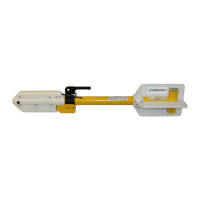Geometrics Inc. G-882 Cesium Marine Magnetometer Page 29
electromagnetic noise and heading error from the ship's induced and remnant
magnetic fields are typically the major contributors to "noise" in the marine
environment.
The G−882 Sensor Package consists of a sensor head and sensor electronics
package joined by a cable. The electronics package contains an integral
Geometrics CM-221 counter which converts the Larmor signal into a
magnetometer reading in nano-Teslas. Digital data is transmitted via RS-232 to
a data logging system. An eight pin underwater connector on the sensor
electronics package receives power on two pins. Three pins are used to provide
an RS-232 connection upon which the G−882 transmits magnetometer data
readings in digital format. The other pin(s) is reserved for future and special
uses.
Environmental conditions for proper operation are -35 to +50°C (-31 to +122° F).
The G−882 will operate to a depth of 4,000 psi (9000 ft.).
4.3 Sensor Orientation Guide
The G−882 is designed so that the sensor optical axis is perpendicular to
direction of the tow. The sensor may be oriented at any angle from vertical to
horizontal by rotating the main fish tube or “T” section.
The sensor head should be oriented so that the earth's field vector arrives at an
angle of from 15 to 75 to the optical axis of the sensor. The earth’s field vector
is vertical at the poles, between 50º and 60º in the mid latitudes and horizontal at
the magnetic equator. (See CSAZ program on Magnetometer CD). Adjusting the
sensor for the polar and mid-latitude regions is simple, by orienting the sensor
either at 45º (rotating the main tube 1/8
th
turn for polar regions) or 0º (no rotation
required at mid-latitudes) respectively. The vast majority of surveys will be
conducted using these two orientations.
The equatorial region is a special case. There is a band of approximately 500
miles wide in which the magnetometer can survey only in certain directions with a
given sensor orientation. For instance, if the survey will be conducted in an east-
west direction at the magnetic equator, simply rotating the sensor to the 45º
position (same as for the polar region) will produce excellent data

